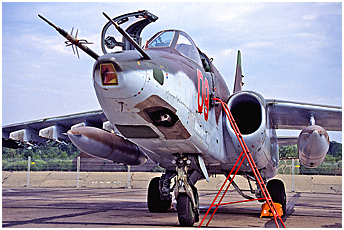
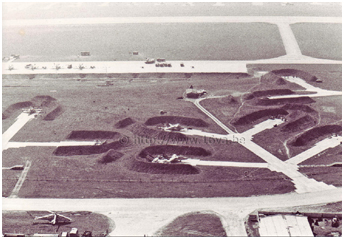 As we saw in the first part of this chapter, Ministry of Defense Directive n°30660 from April 29, 1956, decreed the dismantling of the Shturmovik units.
The fighter-bomber regiments were established the following year. It was not until the mid-seventies that the concept of the attack aircraft came back into fashion in a concrete way with the Sukhoi Su-25 and with it the rebirth of Shturmovik units. At that time, the fighter-bomber aircraft were mainly Su-7B and MiG-21. However, these aircraft were less efficient than the older MiG-17s, which were more maneuverable at lower speeds, as was demonstrated during exercises or during confrontations in the Middle East.
Sukhoi's initiative to develop a new attack aircraft began in March 1968. The project designated T8 was initially less ambitious than the future Su-25 because, being smaller, it was also less armoured and could not have carried as much armament. However, the time had not yet come and the program was rejected in August by the VVS. Nevertheless, development continued privately at Sukhoi and, already the following year, the T8 finally entered into official competition for the production of a new close support aircraft with the projects of Ilyushin (Il-42 later redesignated Il-102 > Link), MiG (MiG-21LSh
> Link) which eventually threw in the towel and Yakovlev (Yak-25LSh rejected out of hand > Link). Another Sukhoi product, the improbable Su-15Sh also was considered because some military would have preferred a supersonic aircraft.
As we saw in the first part of this chapter, Ministry of Defense Directive n°30660 from April 29, 1956, decreed the dismantling of the Shturmovik units.
The fighter-bomber regiments were established the following year. It was not until the mid-seventies that the concept of the attack aircraft came back into fashion in a concrete way with the Sukhoi Su-25 and with it the rebirth of Shturmovik units. At that time, the fighter-bomber aircraft were mainly Su-7B and MiG-21. However, these aircraft were less efficient than the older MiG-17s, which were more maneuverable at lower speeds, as was demonstrated during exercises or during confrontations in the Middle East.
Sukhoi's initiative to develop a new attack aircraft began in March 1968. The project designated T8 was initially less ambitious than the future Su-25 because, being smaller, it was also less armoured and could not have carried as much armament. However, the time had not yet come and the program was rejected in August by the VVS. Nevertheless, development continued privately at Sukhoi and, already the following year, the T8 finally entered into official competition for the production of a new close support aircraft with the projects of Ilyushin (Il-42 later redesignated Il-102 > Link), MiG (MiG-21LSh
> Link) which eventually threw in the towel and Yakovlev (Yak-25LSh rejected out of hand > Link). Another Sukhoi product, the improbable Su-15Sh also was considered because some military would have preferred a supersonic aircraft.
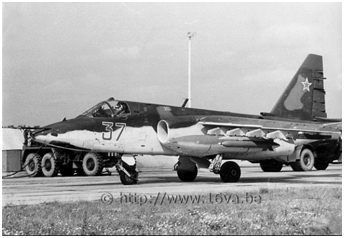
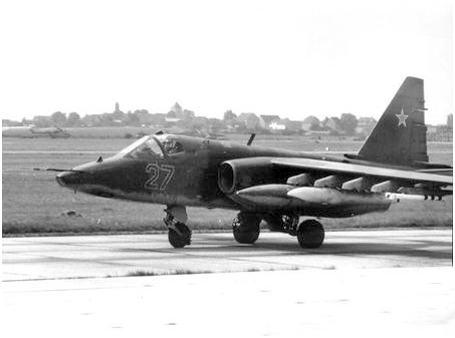 The larger Il-42 was less maneuverable. Although not selected, its development was continued privately later and it made its first flight in 1982 as the Il-102 - the Afghan conflict certainly had something to do with it. However, the Su-25 had already proven itself there. The first prototype of the future Su-25 called T8-1 was to be powered by Ivchenko AI-25T engines, but the Toumanskiy RD-9B engine without PC providing a dry thrust of 2500 kgp was preferred. That motor received the new designation R9-300. The aircraft was equipped with the Su-17M2 weapons system, composed mainly of an ASP-17 collimator, a PBK-3-17S control box, a Fon-1400 laser rangefinder and a KN-23 navigation complex. It was armed with a VPU-22 gondola mounted under the nose, offset to the right. The VPU-22 was derived from the SPPU-22-01 pod. It housed a twin-barreled GSh-2-23 cannon that could swivel downwards to an angle of 23°.
This heavily armoured aircraft also had to be able to be deployed on forward landing strips. The weight and the size of the Su-25 - as it was designated in September 1972 - increased during its development. The payload reached up to four tonnes under ten wing pylons, two of which (later four) were plugged to carry drop tanks. The T8-1 was assembled in Moscow in October 1974 by the Kulon experimental design bureau - as the Sukhoi OKB was called before 1977 - and it was immediately followed by a static test airframe called T8-0. The T8-1 took off for the first time on January 22, 1975 from Zhukovskiy airfield with Vladimir Ilyushin, the Sukhoi's chief test pilot,
at the controls. This was a month behind schedule because of the failure of one of its two reactors. The aircraft then joined the VVS flight test centre in Akhtubinsk in June where it was deemed that young pilots would be able to fly it.
The larger Il-42 was less maneuverable. Although not selected, its development was continued privately later and it made its first flight in 1982 as the Il-102 - the Afghan conflict certainly had something to do with it. However, the Su-25 had already proven itself there. The first prototype of the future Su-25 called T8-1 was to be powered by Ivchenko AI-25T engines, but the Toumanskiy RD-9B engine without PC providing a dry thrust of 2500 kgp was preferred. That motor received the new designation R9-300. The aircraft was equipped with the Su-17M2 weapons system, composed mainly of an ASP-17 collimator, a PBK-3-17S control box, a Fon-1400 laser rangefinder and a KN-23 navigation complex. It was armed with a VPU-22 gondola mounted under the nose, offset to the right. The VPU-22 was derived from the SPPU-22-01 pod. It housed a twin-barreled GSh-2-23 cannon that could swivel downwards to an angle of 23°.
This heavily armoured aircraft also had to be able to be deployed on forward landing strips. The weight and the size of the Su-25 - as it was designated in September 1972 - increased during its development. The payload reached up to four tonnes under ten wing pylons, two of which (later four) were plugged to carry drop tanks. The T8-1 was assembled in Moscow in October 1974 by the Kulon experimental design bureau - as the Sukhoi OKB was called before 1977 - and it was immediately followed by a static test airframe called T8-0. The T8-1 took off for the first time on January 22, 1975 from Zhukovskiy airfield with Vladimir Ilyushin, the Sukhoi's chief test pilot,
at the controls. This was a month behind schedule because of the failure of one of its two reactors. The aircraft then joined the VVS flight test centre in Akhtubinsk in June where it was deemed that young pilots would be able to fly it.
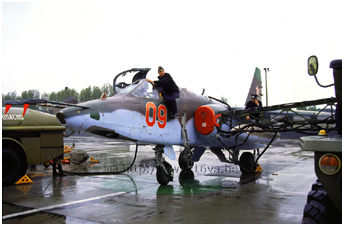
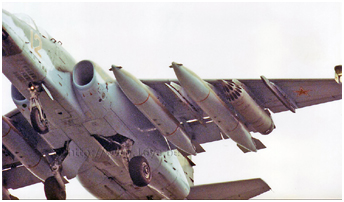 The second prototype T8-2 first flown on December 26, 1975, had various modifications such as the addition of airbrakes on the reactor nacelles - located at the end of the wingtip fairings on the production models - a larger vertical fin and a K-36L ejection seat. However, more powerful reactors were deemed necessary for the series production.
The Tumanskiy R13-300 reactor which powered the MiG-21 was finally chosen, although in a version without PC because a new engine was not available in a reasonable delay. The R-95Sh as it was designated had a thrust of 4100 kg and interestingly was able to burn different types of kerosene and even diesel, but for a limited duration of four hours. The two prototypes were re-engined, while their standards were brought closer to those of future series aircraft.
The T8-2 took off for a new first flight under the designation T8-D2 on December 7, 1976.
The horizontal tail now had positive dihedral and the reactors were offset outwards and also downwards in order to improve their air supply during flights with a high angle of attack.
Mechanical servo-compensators inspired by those of the Cessna A-37B (a South Vietnamese example delivered in 1976) were mounted to relieve the stick forces considered excessive.
By May 1977, the T8 had become representative of a series aircraft. The wingspan and length of the fuselage were increased, the engines were mounted in new nacelles and the pilot was protected by a sort of titanium armored bathtub whose thickness ranged from 10 to 24 mm. The VPU-22 gun pod had given way to a VPU-17A pack - this time mounted to the left side of the nose - comprising an integrated twin-barrel GSh-30 cannon with a rate of fire of 3,000 rounds/minute fed with 250 rounds, while the Su-17M2 weapon system had given way to that of the Su-17M3 with its Klen-PS laser rangefinder and target designator.
The T8-1 was modified to be close to the series aircraft and flew again as the T8-1D on June 21, 1978.
Factory n°31 of Tbilisi in the Georgia SSR was chosen to manufacture the Su-25 (582 aircraft built), where it replaced the MiG-21UM on the production lines. Four pre-production aircraft (T8-3 to -6) were built between the summer of 1978 and 1980. In the meantime, the USSR had taken action in Afghanistan in December 1979. This country was a providential theater of operations for the Shturmoviks. Unsurprisingly, the decision was made to test the Su-25 in real conditions without further delay.
The second prototype T8-2 first flown on December 26, 1975, had various modifications such as the addition of airbrakes on the reactor nacelles - located at the end of the wingtip fairings on the production models - a larger vertical fin and a K-36L ejection seat. However, more powerful reactors were deemed necessary for the series production.
The Tumanskiy R13-300 reactor which powered the MiG-21 was finally chosen, although in a version without PC because a new engine was not available in a reasonable delay. The R-95Sh as it was designated had a thrust of 4100 kg and interestingly was able to burn different types of kerosene and even diesel, but for a limited duration of four hours. The two prototypes were re-engined, while their standards were brought closer to those of future series aircraft.
The T8-2 took off for a new first flight under the designation T8-D2 on December 7, 1976.
The horizontal tail now had positive dihedral and the reactors were offset outwards and also downwards in order to improve their air supply during flights with a high angle of attack.
Mechanical servo-compensators inspired by those of the Cessna A-37B (a South Vietnamese example delivered in 1976) were mounted to relieve the stick forces considered excessive.
By May 1977, the T8 had become representative of a series aircraft. The wingspan and length of the fuselage were increased, the engines were mounted in new nacelles and the pilot was protected by a sort of titanium armored bathtub whose thickness ranged from 10 to 24 mm. The VPU-22 gun pod had given way to a VPU-17A pack - this time mounted to the left side of the nose - comprising an integrated twin-barrel GSh-30 cannon with a rate of fire of 3,000 rounds/minute fed with 250 rounds, while the Su-17M2 weapon system had given way to that of the Su-17M3 with its Klen-PS laser rangefinder and target designator.
The T8-1 was modified to be close to the series aircraft and flew again as the T8-1D on June 21, 1978.
Factory n°31 of Tbilisi in the Georgia SSR was chosen to manufacture the Su-25 (582 aircraft built), where it replaced the MiG-21UM on the production lines. Four pre-production aircraft (T8-3 to -6) were built between the summer of 1978 and 1980. In the meantime, the USSR had taken action in Afghanistan in December 1979. This country was a providential theater of operations for the Shturmoviks. Unsurprisingly, the decision was made to test the Su-25 in real conditions without further delay.
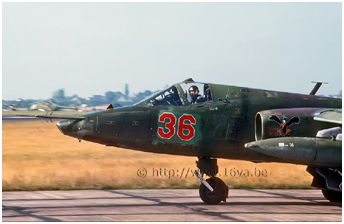
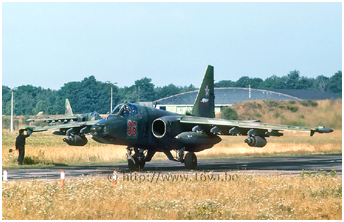 The T8-1D and the T8-3 made 100 flights in about fifty days from Shindand airfield located at an altitude of 1140 meters as part of the Romb operation. Fourty-four combat missions were flown between April and June 1980. Other pre-series airraft joined the first ones to keep on the combat evaluation of the Su-25. 186 sorties had been carried out by December 1980. On June 23, 1980, the T8-5 intended to study the behavior in a spin was lost with its pilot after a wing broke at 7.5G while the aircraft was at that time limited to 5G (6.5G in 1984). The quality of aircraft manufacture in Tbilisi left something to be desired during that period.
The Afghan experience being considered conclusive, the first Su-25 unit was established on February 4, 1981 as the 200.OShAE. The independent squadron moved to Shindand on April 18 and 19. Also, the 80.OShAP was activated in Sitalchay in the Azerbaijan SSR, while tests continued with the prototypes. Thus, for example, the possibility of firing S-8 rockets backwards to neutralize the defenses after a firing pass was tested with the T8-10.
The first series aircraft had four ASO-2V flare launchers, each capable of firing 32 PPI-26 IR cartridges, mounted in the tail fairing of the parachute behind the rudder. Four more ASO-2VM modules were later added to the rear part of the engine nacelles, which allowed to increase the number of firing passes. From the very beginning, special measures were taken to ensure the survivability of the Su-25. In addition to the armour protecting the pilot and engines, the self-sealing fuel tanks were filled at 70% with polyurethane to prevent them from explosing. All the various protective measures, excluding fire extinguishers, weighed 755 kg. As the threat from Stinger surface-to-air missiles increased, the mounting of a SOEP-V1A Lipa IR jammer as on the Mi-24 was considered, however, this was not possible in a short time. Also, the resilience of the airframe was further increased by various measures aimed at protecting or hardening the engines and flight control areas (1).
Although the new aircraft was spotted by the West as early as 1977 when a US satellite photographed it at Ramenskoye (as Zhukovskiy was known in the West; it was then given the provisional designation "Ram-J" - the 10th (J) aircraft identified at Ramenskoye) it was not until 1982, during its operations in Afghanistan, that the Su-25 was finally christened "Frogfoot" by NATO.
The T8-1D and the T8-3 made 100 flights in about fifty days from Shindand airfield located at an altitude of 1140 meters as part of the Romb operation. Fourty-four combat missions were flown between April and June 1980. Other pre-series airraft joined the first ones to keep on the combat evaluation of the Su-25. 186 sorties had been carried out by December 1980. On June 23, 1980, the T8-5 intended to study the behavior in a spin was lost with its pilot after a wing broke at 7.5G while the aircraft was at that time limited to 5G (6.5G in 1984). The quality of aircraft manufacture in Tbilisi left something to be desired during that period.
The Afghan experience being considered conclusive, the first Su-25 unit was established on February 4, 1981 as the 200.OShAE. The independent squadron moved to Shindand on April 18 and 19. Also, the 80.OShAP was activated in Sitalchay in the Azerbaijan SSR, while tests continued with the prototypes. Thus, for example, the possibility of firing S-8 rockets backwards to neutralize the defenses after a firing pass was tested with the T8-10.
The first series aircraft had four ASO-2V flare launchers, each capable of firing 32 PPI-26 IR cartridges, mounted in the tail fairing of the parachute behind the rudder. Four more ASO-2VM modules were later added to the rear part of the engine nacelles, which allowed to increase the number of firing passes. From the very beginning, special measures were taken to ensure the survivability of the Su-25. In addition to the armour protecting the pilot and engines, the self-sealing fuel tanks were filled at 70% with polyurethane to prevent them from explosing. All the various protective measures, excluding fire extinguishers, weighed 755 kg. As the threat from Stinger surface-to-air missiles increased, the mounting of a SOEP-V1A Lipa IR jammer as on the Mi-24 was considered, however, this was not possible in a short time. Also, the resilience of the airframe was further increased by various measures aimed at protecting or hardening the engines and flight control areas (1).
Although the new aircraft was spotted by the West as early as 1977 when a US satellite photographed it at Ramenskoye (as Zhukovskiy was known in the West; it was then given the provisional designation "Ram-J" - the 10th (J) aircraft identified at Ramenskoye) it was not until 1982, during its operations in Afghanistan, that the Su-25 was finally christened "Frogfoot" by NATO.
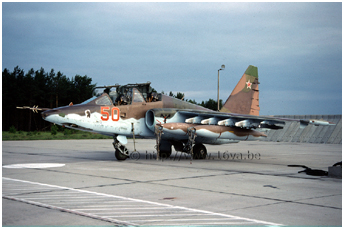
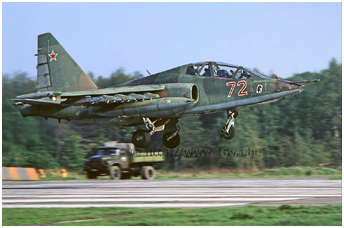 The Su-25 was intended for the direct support of the troops and was not supposed to venture beyond 50 km from the front line. The Su-17s provided strikes beyond 150 km, while the Su-24 bombers were to penetrate deeper into enemy territory to 300 km. The main equipment of the weapon system included an ASP-17BTs-8 HUD, the Klen-PS laser rangefinder associated with a signal control and correction system designated Metka and a KN-23-1 navigation complex. In addition to the flare launchers already mentioned above, the aircraft had an SPO-15 radar warning receiver and could carry an SPS-141MVG Gvozdika ECM pod.
The Su-25 equipped with ten hardpoints could carry, in addition to bombs weighing 100 to 500 kg (four tons of bombs for a total payload of 4,400 kg), up to eight classic B-8M1 and UB-32M rocket pods, or a similar quantity of S-13, S-24 or S-25 rockets. The laser-guided weapons used were Kh-25ML (4 units) and Kh-29L (2 units) missiles, as well as S-25L rockets (4 units). The Kh-25MTP IR-guided missiles were also part of the Su-25's arsenal. Also, four SPPU-22-1 (GSh-23) or SPPU-687 (GSh-301) cannon pods or eight KMGU-2 cluster munitions containers could be carried. Outboard pylons were used to carry two R-3S or R-60/M missiles. It was of course possible to carry drop tanks, namely four PTB-800 or PTB-1150. The Kh-58U anti-radar missile also was part of the Su-25's weapons suite.
During the Afghan conflict, firing laser-guided weapons sometimes was facilitated by the use of BTR-80 vehicles equipped with a Klen-PS laser rangefinder/target designator mounted in a retractable turret, which designated targets for the Su-25s (> Link). The use of such a system further increased the accuracy of fire, making it possible to target, for example, the entrance to a cave. Were such complexes designated BOMAN (combat vehicle for aircraft guidance) deployed in the GDR? There is no evidence of this in the current state of our knowledge.
The Su-25 was intended for the direct support of the troops and was not supposed to venture beyond 50 km from the front line. The Su-17s provided strikes beyond 150 km, while the Su-24 bombers were to penetrate deeper into enemy territory to 300 km. The main equipment of the weapon system included an ASP-17BTs-8 HUD, the Klen-PS laser rangefinder associated with a signal control and correction system designated Metka and a KN-23-1 navigation complex. In addition to the flare launchers already mentioned above, the aircraft had an SPO-15 radar warning receiver and could carry an SPS-141MVG Gvozdika ECM pod.
The Su-25 equipped with ten hardpoints could carry, in addition to bombs weighing 100 to 500 kg (four tons of bombs for a total payload of 4,400 kg), up to eight classic B-8M1 and UB-32M rocket pods, or a similar quantity of S-13, S-24 or S-25 rockets. The laser-guided weapons used were Kh-25ML (4 units) and Kh-29L (2 units) missiles, as well as S-25L rockets (4 units). The Kh-25MTP IR-guided missiles were also part of the Su-25's arsenal. Also, four SPPU-22-1 (GSh-23) or SPPU-687 (GSh-301) cannon pods or eight KMGU-2 cluster munitions containers could be carried. Outboard pylons were used to carry two R-3S or R-60/M missiles. It was of course possible to carry drop tanks, namely four PTB-800 or PTB-1150. The Kh-58U anti-radar missile also was part of the Su-25's weapons suite.
During the Afghan conflict, firing laser-guided weapons sometimes was facilitated by the use of BTR-80 vehicles equipped with a Klen-PS laser rangefinder/target designator mounted in a retractable turret, which designated targets for the Su-25s (> Link). The use of such a system further increased the accuracy of fire, making it possible to target, for example, the entrance to a cave. Were such complexes designated BOMAN (combat vehicle for aircraft guidance) deployed in the GDR? There is no evidence of this in the current state of our knowledge.
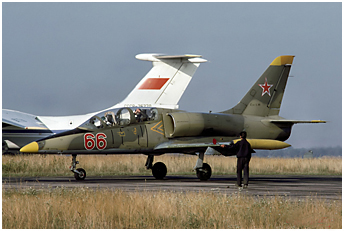
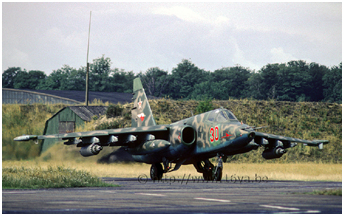 Su-25 pilot training was initially conducted on the Su-17UM3 due to the similarity of the weapon systems. However, the Aero L-39C Albatros was later preferred since the flight characteristics of the Fitter were very different. In 1985, a two-seater version of the Su-25 was quickly created by adding a second cockpit and increasing the tail area. The first pre-production aircraft designated T8UB-1 took off from Ulan-Ude in Buryatia on August 6, 1985, followed later by the T8UB-2. Serial production of the Su-25UB began at Ulan-Ude Plant n°99 in 1987. The two-seaters were sometimes decorated with the city's emblem, consisting of a shield with a bear. Although 200 Su-25UBs were produced between 1986 and 1992, the Su-25 squadrons were still equipped with L-39C alongside the Su-25UB when they left Germany. Eight L-39 in total equipped the two regiments of the 16.VA. Although without an internal cannon, these aircraft nevertheless had two wing pylons intended to carry P-50 training bombs or UB-16-57 rocket launcher pods. The supply of spare parts from Czechoslovakia was disrupted following the disbandment of the Warsaw Pact on July 1, 1991. There also was a flight simulator dedicated to the Su-25 designated KTS-18.
Su-25 pilot training was initially conducted on the Su-17UM3 due to the similarity of the weapon systems. However, the Aero L-39C Albatros was later preferred since the flight characteristics of the Fitter were very different. In 1985, a two-seater version of the Su-25 was quickly created by adding a second cockpit and increasing the tail area. The first pre-production aircraft designated T8UB-1 took off from Ulan-Ude in Buryatia on August 6, 1985, followed later by the T8UB-2. Serial production of the Su-25UB began at Ulan-Ude Plant n°99 in 1987. The two-seaters were sometimes decorated with the city's emblem, consisting of a shield with a bear. Although 200 Su-25UBs were produced between 1986 and 1992, the Su-25 squadrons were still equipped with L-39C alongside the Su-25UB when they left Germany. Eight L-39 in total equipped the two regiments of the 16.VA. Although without an internal cannon, these aircraft nevertheless had two wing pylons intended to carry P-50 training bombs or UB-16-57 rocket launcher pods. The supply of spare parts from Czechoslovakia was disrupted following the disbandment of the Warsaw Pact on July 1, 1991. There also was a flight simulator dedicated to the Su-25 designated KTS-18.
In September 1985, the 357th Independent Assault Aviation Regiment (Otdelniy Shturmovoy Aviatsionniy Polk - OShAP) that was activated on February 1 in Pruzhany in Belarus, gradually took up residence in Brandis near Leipzig. The 225th Independent Combat Helicopter Regiment (OBVP) previously stationed on the same airbase had moved to Allstedt to make way for the new Su-25s. This game of musical chairs continued with the
transfer of the 292nd Independent Electronic Warfare Helicopter Squadron (OVE REB) from Allstedt to Cochstedt (> Link), while the 327th Independent Fire Support Helicopter Squadron (OVE OP) also left Allstedt, but for Schlotheim.
The 357.OShAP had in its ranks 14 Su-25s of the first production series, 15 of the 10th series, 2 Su-25UBs and 4 L-39Cs.
Although little documented and even questionable, some writings of Russian origin mention the existence of a nuclear capacity for the Su-25. Thus, according to A. Kozhemyakine and A. Korotkov, specialists of the Su-25,
the first squadron of the 357.OShAP had a nuclear attack mission. Training in loading a nuclear weapon took place once or twice a month. The "deaf-mutes" (the personnel responsible for nuclear weapons) carried out the loading of the special bomb either inside a closed maintenance hangar in the summer, or outside in a dispersal in the winter after dark. Once the ground crew had finished their work and entered the codes, it was the pilot's turn to enter his. Then the weapon was removed and stored again. That squadron flew essentially at night.
The second squadron could carry out missions other than ground attack, such as reconnaissance, while the third squadron trained the young pilots.
The designated firing range of the 357.OChAP was that of Belgern. While firing cannon and unguided rockets was commonplace, as was the dropping of light bombs or OFAB-250ShN parachute-retarded bombs, firing air-to-ground missiles was rare, as was the use of SPPU-22 cannon pods.
| ORBAT 1976 - 1994 |
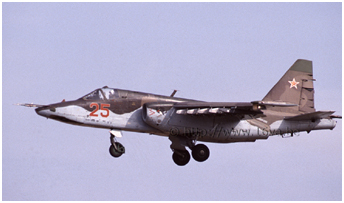
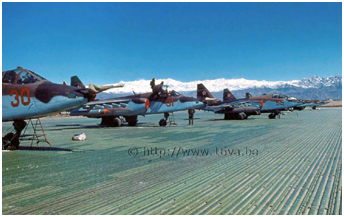 The 357.OShAP was the only one of its kind in the GDR. However, as the Soviet presence in Afghanistan was slowly coming to an end, it was rejoined three years later by
the 368.OShAP. The unit was established in the Carpathian Military District at Zhovtnevoe near Lvov on July 12, 1984. It started flying from Kalinov in September 1984 with Su-25 of the 2nd and 4th series obtained from the 760.IIAP of the 4.TsBP i PLS from Lipetsk.
Pilots and ground personnel of the regiment were sent to Afghanistan from October 1986, where they were assigned to the 378.OChAP. The latter employed mixed personnel from the other Shturmovik units.
The first and second squadrons of the 378.OShAP were based in Bagram and the third in Kandahar. In October 1988, 62 pilots and technicians of the 368.OShAP joined the third squadron of the 378.OShAP that was relocated at Shindand. In the meantime, the 1.AE and 2.AE of the 368.OShAP - partly re-equipped with aircraft of the 10th series - had moved in May to Tchortkov in Ukraine. The aircraft of the first series belonging to the 3rd squadron were transferred to other units.
The regiment finally moved to the GDR on December 18, 1988, where it took residence in Demmin-Tutow. Pilots of the 357.OShAP helped ferry aircraft of the 368.OShAP from Chortkov to Demmin.
The 357.OShAP was the only one of its kind in the GDR. However, as the Soviet presence in Afghanistan was slowly coming to an end, it was rejoined three years later by
the 368.OShAP. The unit was established in the Carpathian Military District at Zhovtnevoe near Lvov on July 12, 1984. It started flying from Kalinov in September 1984 with Su-25 of the 2nd and 4th series obtained from the 760.IIAP of the 4.TsBP i PLS from Lipetsk.
Pilots and ground personnel of the regiment were sent to Afghanistan from October 1986, where they were assigned to the 378.OChAP. The latter employed mixed personnel from the other Shturmovik units.
The first and second squadrons of the 378.OShAP were based in Bagram and the third in Kandahar. In October 1988, 62 pilots and technicians of the 368.OShAP joined the third squadron of the 378.OShAP that was relocated at Shindand. In the meantime, the 1.AE and 2.AE of the 368.OShAP - partly re-equipped with aircraft of the 10th series - had moved in May to Tchortkov in Ukraine. The aircraft of the first series belonging to the 3rd squadron were transferred to other units.
The regiment finally moved to the GDR on December 18, 1988, where it took residence in Demmin-Tutow. Pilots of the 357.OShAP helped ferry aircraft of the 368.OShAP from Chortkov to Demmin.
The 357. and 368.OShAP were located directly facing their potential combat zones, namely the Fulda Gap (a geological collapse in the Thuringian massif) and the great plain of northern Germany. As was the case with helicopter bases, neither Brandis nor Tutow airbase had hardened aircraft shelters to protect their aircraft. The versatile Su-25s indeed would have been dispersed by section (Aviatsionniy Zveno - AZ), on aero-club airfields or on makeshift runways, in the immediate vicinity of the combat zones.
The ability to carry out operations outside the infrastructure of a conventional air base had also been pushed very far with the Su-25.
The AMK-8 complex was designed to allow a section of four "Frogfoot" to work in complete autonomy for a period of five days from a forward terrain, provided that fuel and ammunition were available on site.
The AMK-8 complex was composed of four special containers (> Link).
The first (K1-E) carried a starting unit (APU) in order to start the engines, activate the winches to lift the armament and carry out tests of the various aircraft equipment before the flight
(Chadian Su-25K with an open K1-E container > Link );
the second (K2-D) contained fuel, oil, hydraulic fluid and oxygen refueling systems (> Link);
the third (K3-SNO) housed the protective tarpaulins, air intake covers, chocks, tools, a folding ladder, spare parts and an electric winch for ammunition; as for the fourth (K4-KPA) it transported the test equipment.
The addition of a fifth container intended for the transport of a mechanic was considered by some customers, but not retained!
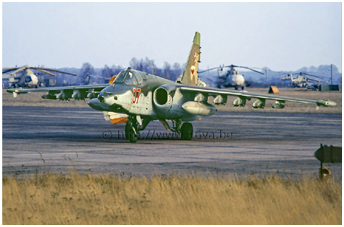
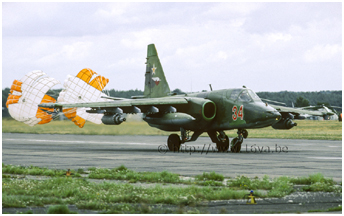 The two assault regiments based in the GDR, unlike their colleagues equipped with MiG-27 "Flogger" and Su-17 "Fitter", were not assigned to a division but were directly under the control of the 16.VA.
A special mission requires a special control. Familiarly called Grach (Rook), most of the Su-25 "Frogfoot-A" of the 16.VA displayed on their left air intake a humorous representation of the black bird of our countryside. This emblem was a legacy of the Afghanistan campaign, when it was applied for the first time on an aircraft at the end of 1984. However, it did not mean that the aircraft adorned with it had actually fought in this theatre of operations. Thus, Demmin's aircraft, none of which took part in the conflict, received these emblems shortly before leaving for the GDR.
Let us mention for the record the "oriental" type architecture of the SLB35 building (> Link) housing the approach beacon and its maintenance personnel which was located at the end of the eastern end of the Demmin runway, probably inherited from the Afghan experience! In 1990, particular attention was paid to the training of combat-ready operational pilots within the 368.OShAP. Twelve pilots were qualified in air-to-ground missile firing.
The regiment was positively evaluated during a period of deployment in Luninets between June 1 and 8. Also in 1990, a significant personnel rotation took place, when
practically the equivalent of a squadron moved from Sitalchay to Demmin. That same year, the regiment fielded around thirty Su-25s including 12 Su-25BMs and three Su-25UBs. Ten Su-25BMs and one Su-25UB came from the 65.OBAE (see below). The regiment also had four L-39C.
The two assault regiments based in the GDR, unlike their colleagues equipped with MiG-27 "Flogger" and Su-17 "Fitter", were not assigned to a division but were directly under the control of the 16.VA.
A special mission requires a special control. Familiarly called Grach (Rook), most of the Su-25 "Frogfoot-A" of the 16.VA displayed on their left air intake a humorous representation of the black bird of our countryside. This emblem was a legacy of the Afghanistan campaign, when it was applied for the first time on an aircraft at the end of 1984. However, it did not mean that the aircraft adorned with it had actually fought in this theatre of operations. Thus, Demmin's aircraft, none of which took part in the conflict, received these emblems shortly before leaving for the GDR.
Let us mention for the record the "oriental" type architecture of the SLB35 building (> Link) housing the approach beacon and its maintenance personnel which was located at the end of the eastern end of the Demmin runway, probably inherited from the Afghan experience! In 1990, particular attention was paid to the training of combat-ready operational pilots within the 368.OShAP. Twelve pilots were qualified in air-to-ground missile firing.
The regiment was positively evaluated during a period of deployment in Luninets between June 1 and 8. Also in 1990, a significant personnel rotation took place, when
practically the equivalent of a squadron moved from Sitalchay to Demmin. That same year, the regiment fielded around thirty Su-25s including 12 Su-25BMs and three Su-25UBs. Ten Su-25BMs and one Su-25UB came from the 65.OBAE (see below). The regiment also had four L-39C.
In November 1989, the MiG-23Ms of the 65th Independent Towing (Target) Aviation Squadron (OBAE) of Damgarten were withdrawn from service in favor of about ten Su-25BMs - BM for Buksirovshchik Misheney - target tug
(see > The target-towing units, part 2). The Su-25BM was a new multi-purpose attack and target towing version
equipped with more powerful R195 engines (4,300 kgp instead of 4,100 kgp for the R95Sh) with reduced thermal emissions, a long-range RSDB-10 radio navigation set and
the systems required to tow air targets to train the anti-aircraft defense and the fighters.
Thus, the Su-25BM were supposed to carry under the left wing the container of the Kometa complex, 2M13 long and weighing 46kg. The latter consisted of a TL-70 turbine-powered towing winch (> Link) and a target towed behind a 2300-3000 meter long cable that could be detected by radar or IR sensors and shot at in visual conditions.
When the winch pod was mounted under the left wing, an aerodynamic counterweight resembling a bomb was attached under the right wing as compensation. The target was fixed to a deployable support under the rear part of the winch container.
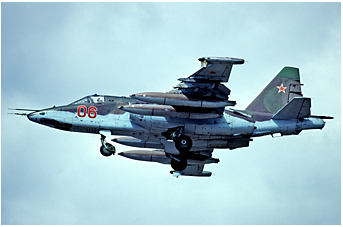
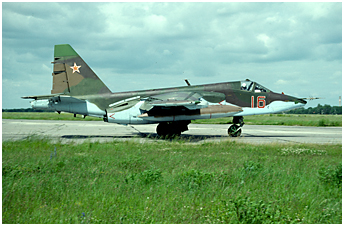 In addition, up to four PM-6 rocket-propelled targets, designed to simulate diving aircraft or glide bombs, could be fixed under suitable pylons.
It was not possible to carry more than two PM-6s when two drop tanks were attached underwing. M6-type targets were also used with the Su-25BM.
The Su-25BM could easily be distinguished from the standard Su-25 by a small air intake mounted under the rear part of the engine nacelles (with a slightly modified shape at the rear)
associated with a jet dilutor mounted in the nozzles in order to reduce the IR signature of the engines, as well as by the presence of another larger air intake located on the top of the nacelles.
The latter replaced the dual air intake that was previously installed at the base of the fin and which was intended for cooling the generators driven by the jet engines.
The combination of new engines and an improved navigation suite made this version of the "Frogfoot-A," the most efficient of the time. It had originally been planned to produce a total of 170 Su-25BMs,
however, only about fifty of them were actually delivered before the Tbilisi factory became the property of the new Georgian state following the
disintegration of the Soviet Union. Using the Kometa system by the aircraft of the 65.OBAE is excluded, since the initial tests were not completed until October 1991.
In addition, since the TL-70 winches were also to be built in Tbilisi, they were not delivered and, to top it all off, the PM-6 targets also became unavailable because they were produced in Dubovaya in Ukraine.
Thus, the Su-25BMs did not perform any target towing. The aircraft based in Damgarten nevertheless were able to carry out their mission using M6 and PM-6 targets.
In addition, up to four PM-6 rocket-propelled targets, designed to simulate diving aircraft or glide bombs, could be fixed under suitable pylons.
It was not possible to carry more than two PM-6s when two drop tanks were attached underwing. M6-type targets were also used with the Su-25BM.
The Su-25BM could easily be distinguished from the standard Su-25 by a small air intake mounted under the rear part of the engine nacelles (with a slightly modified shape at the rear)
associated with a jet dilutor mounted in the nozzles in order to reduce the IR signature of the engines, as well as by the presence of another larger air intake located on the top of the nacelles.
The latter replaced the dual air intake that was previously installed at the base of the fin and which was intended for cooling the generators driven by the jet engines.
The combination of new engines and an improved navigation suite made this version of the "Frogfoot-A," the most efficient of the time. It had originally been planned to produce a total of 170 Su-25BMs,
however, only about fifty of them were actually delivered before the Tbilisi factory became the property of the new Georgian state following the
disintegration of the Soviet Union. Using the Kometa system by the aircraft of the 65.OBAE is excluded, since the initial tests were not completed until October 1991.
In addition, since the TL-70 winches were also to be built in Tbilisi, they were not delivered and, to top it all off, the PM-6 targets also became unavailable because they were produced in Dubovaya in Ukraine.
Thus, the Su-25BMs did not perform any target towing. The aircraft based in Damgarten nevertheless were able to carry out their mission using M6 and PM-6 targets.
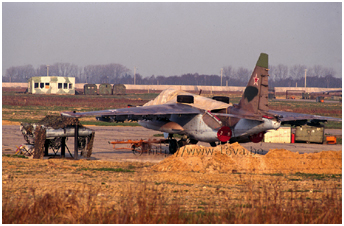
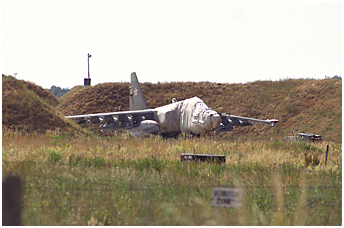 Ten new Su-25BMs were ferried from Tbilisi to Damgarten in May 1990 for the 65.OBAE. A new Su-25UB had also been received by the unit
the previous month. Also, by the end of July 1990 at the latest, two new Su-25BMs joined directly the 368.OShAP.
In October 1990, the aircraft of the 65.OBAE were redeployed to Demmin and the squadron personnel were divided between the 357.OShAP and the fourth squadron of the 368.OShAP
(2).
The 65.OBAE was disbanded on November 1, 1990. The yellow codes that the planes wore within this squadron were painted over in red (and sometimes changed) in order to bring them into line with those of the 368.OShAP.
A good part of the 12 Su-25BM was assigned to the 1.AE, while 16 Su-25s of the 368.OShAP were transferred to Brandis where they probably replaced the aircraft with the least remaining potential.
The 357.OShAP then included the first squadron with 10 single-seater aircraft all from Demmin and 2 two-seaters, while the second and third squadrons each had 10 aircraft in their inventory. The regiment also had four Aero L-39Cs. The withdrawal of the Su-25s from Germany began in the spring of 1992. It started with the 357.OShAP when the L-39C training aircraft were transferred to Kobrin in Belarus on March 28, and a handful of Su-25s to Tutow. One month later, on April 28, 1992, the 357.OShAP flew its last twenty-four "Frogfoot" to Buturlinovka, southeast of Voronezh, where the regiment was disbanded the following month. The aircraft of the unit were handed over among several units. About fifteen aircraft left their temporary storage in Buturlinovka to join the 18.GvShAP "Normandie-Niemen" in Galenki in the Far East. A few remained behind to join the local 899.OShAP (3). This unit, which took up the traditions of the 15.IAP, was reactivated in 1992, first as the 899.IShAP based on the 186th Assault Aviation Training Regiment (186.IShAP) stationed on the same airfield. The designation of 899.OShAP was made official on July 1, 1993.
This unit was the only Shturmovik regiment assigned to the new 16.VA of Kubinka on December 1, 1993.
Ten new Su-25BMs were ferried from Tbilisi to Damgarten in May 1990 for the 65.OBAE. A new Su-25UB had also been received by the unit
the previous month. Also, by the end of July 1990 at the latest, two new Su-25BMs joined directly the 368.OShAP.
In October 1990, the aircraft of the 65.OBAE were redeployed to Demmin and the squadron personnel were divided between the 357.OShAP and the fourth squadron of the 368.OShAP
(2).
The 65.OBAE was disbanded on November 1, 1990. The yellow codes that the planes wore within this squadron were painted over in red (and sometimes changed) in order to bring them into line with those of the 368.OShAP.
A good part of the 12 Su-25BM was assigned to the 1.AE, while 16 Su-25s of the 368.OShAP were transferred to Brandis where they probably replaced the aircraft with the least remaining potential.
The 357.OShAP then included the first squadron with 10 single-seater aircraft all from Demmin and 2 two-seaters, while the second and third squadrons each had 10 aircraft in their inventory. The regiment also had four Aero L-39Cs. The withdrawal of the Su-25s from Germany began in the spring of 1992. It started with the 357.OShAP when the L-39C training aircraft were transferred to Kobrin in Belarus on March 28, and a handful of Su-25s to Tutow. One month later, on April 28, 1992, the 357.OShAP flew its last twenty-four "Frogfoot" to Buturlinovka, southeast of Voronezh, where the regiment was disbanded the following month. The aircraft of the unit were handed over among several units. About fifteen aircraft left their temporary storage in Buturlinovka to join the 18.GvShAP "Normandie-Niemen" in Galenki in the Far East. A few remained behind to join the local 899.OShAP (3). This unit, which took up the traditions of the 15.IAP, was reactivated in 1992, first as the 899.IShAP based on the 186th Assault Aviation Training Regiment (186.IShAP) stationed on the same airfield. The designation of 899.OShAP was made official on July 1, 1993.
This unit was the only Shturmovik regiment assigned to the new 16.VA of Kubinka on December 1, 1993.
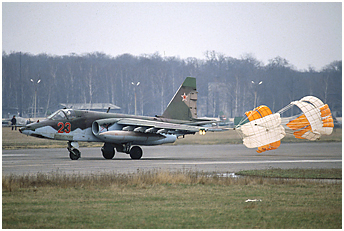
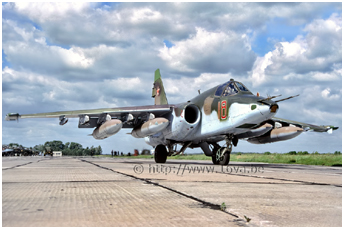 The turn of the "Frogfoot" of the 368.OShAP from Tutow came one year after the departure of the 357.OShAP. On June 15, 1993, the thirty-five Su-25s of the 368.OChAP, under the command of Colonel Nikolai Ivanovich Tankuchine, started their journey with a short hop to Gross Dölln due to the unsufficient quantity of fuel remaining at Demmin to allow their direct transfer to the CIS. They finally left the next day, on June 16, to reach Budennovsk, an airfield located in the heart of the Caucasus, after several stopovers. Also in June, the regiment became the 368.ShAP and changed its field post number when it was subordinate to the 1.GvShAD (Shturmovaya Aviatsionnaya Diviziya) of Krasnodar on the Kuban. The regiment became part of the 4th Army of the VVS & PVO (formerly 4.VA) of Rostov-on-Don.
On July 20, the 368.ShAP came under the command of Colonel Sergey K. Borisyuk who was nobody else than the last commander of the 559.APIB of Finsterwalde! (in photo in the 5th part of this chapter).
In August, support units (communication and maintenance) were repatriated from Demmin to Budennovsk and flights finally resumed only in November.
The Su-25s from Germany were, however, to make a comeback to the forefront of current events since, due to their very particular profile, they found an unexpected use during the conflicts that regularly shook the borders of the former Soviet empire in Abkhazia, Tajikistan, or between December 1994 and August 1996 in self-proclaimed Chechnya.
Later still, the 368.ShAP, alongside the 11.ORAP, 599.BAP and 487.OVP BU (4)
also formerly stationed in the GDR, took part in the Georgian conflict of August 2008 where it lost three Su-25s (1 pilot wounded and one killed) including one shot down by friendly fire. It should also be noted for the record that an old Su-25 of the 357.OShAP was identified by its construction number as having been delivered to the Iraqi Air Force.
We will not dwell on the likely role of Su-25s of 368.ShAP in the Russo-Ukrainian war that began in February 2022 because this is largely outside the scope of this site and finding reliable information is a fantasy.
The turn of the "Frogfoot" of the 368.OShAP from Tutow came one year after the departure of the 357.OShAP. On June 15, 1993, the thirty-five Su-25s of the 368.OChAP, under the command of Colonel Nikolai Ivanovich Tankuchine, started their journey with a short hop to Gross Dölln due to the unsufficient quantity of fuel remaining at Demmin to allow their direct transfer to the CIS. They finally left the next day, on June 16, to reach Budennovsk, an airfield located in the heart of the Caucasus, after several stopovers. Also in June, the regiment became the 368.ShAP and changed its field post number when it was subordinate to the 1.GvShAD (Shturmovaya Aviatsionnaya Diviziya) of Krasnodar on the Kuban. The regiment became part of the 4th Army of the VVS & PVO (formerly 4.VA) of Rostov-on-Don.
On July 20, the 368.ShAP came under the command of Colonel Sergey K. Borisyuk who was nobody else than the last commander of the 559.APIB of Finsterwalde! (in photo in the 5th part of this chapter).
In August, support units (communication and maintenance) were repatriated from Demmin to Budennovsk and flights finally resumed only in November.
The Su-25s from Germany were, however, to make a comeback to the forefront of current events since, due to their very particular profile, they found an unexpected use during the conflicts that regularly shook the borders of the former Soviet empire in Abkhazia, Tajikistan, or between December 1994 and August 1996 in self-proclaimed Chechnya.
Later still, the 368.ShAP, alongside the 11.ORAP, 599.BAP and 487.OVP BU (4)
also formerly stationed in the GDR, took part in the Georgian conflict of August 2008 where it lost three Su-25s (1 pilot wounded and one killed) including one shot down by friendly fire. It should also be noted for the record that an old Su-25 of the 357.OShAP was identified by its construction number as having been delivered to the Iraqi Air Force.
We will not dwell on the likely role of Su-25s of 368.ShAP in the Russo-Ukrainian war that began in February 2022 because this is largely outside the scope of this site and finding reliable information is a fantasy.
 |
Su-25 & L-39 PHOTO PAGE |  |
 |
Su-25 ex-65.OBAE PHOTO PAGE |  |
 |
Prisoners of the "Red Army" |  |
notes
(1)
In eight years of war in Afghanistan, 23 Su-25s were lost in 60,000 sorties. 38 in total were actually written off.
(2)
In 1989, many units were disbanded and consequently many pilots found themselves without planes. It was thus decided to create a fourth
squadron in several regiments, while the number of aircraft in service with these same units remained the same. The excess pilots in the fourth
squadrons flew the planes in the three squadrons, constituting a traditional regiment. It is not certain that an additional squadron was set up
within the 357.OShAP at Brandis. However, this was the case at Demmin where, according to official documents, a fourth squadron was set up
in November 1989.
(3)
Became, by perpetuation of the traditions of the 20.GvAPIB disbanded on May 1, 1998, the 899.GvChAP!
(4)
- 11.ORAP (4.A VVSiPVO), formerly based in Welzow flying Su-24MR - equipment unchanged, based in Marinovka in 2008.
- 599.BAP (4.A VVSiPVO), formerly 559.APIB based in Finsterwalde (MiG-27K). Equipped with Su-24M and based in Morozovsk in 2008.
- 487.OVP BU (4.A VVSiPVO), formerly based in Werneuchen and flying Mi-8 and Mi-24 versions. Some helicopters upgraded + Mi-9.
Based in Buddenovsk in 2008.
 |
Plan du site - Sitemap |  |
